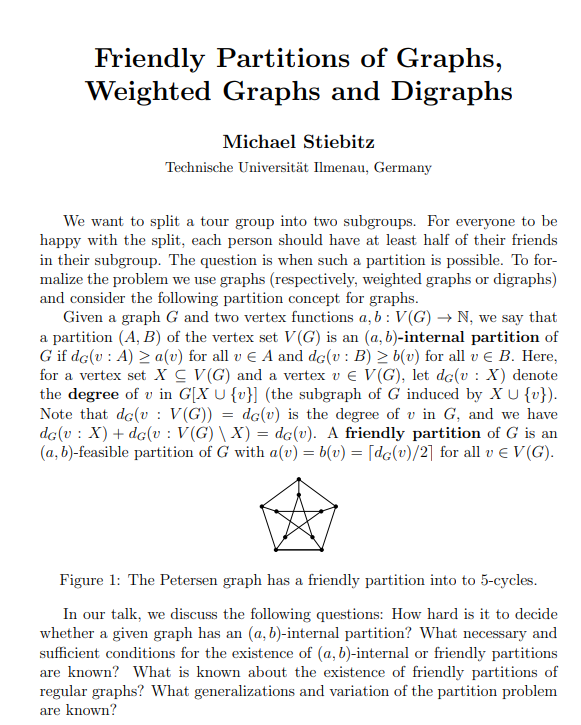
Michael Stiebitz – Graph Theorist & Professor Emeritus
He is a renowned mathematician specializing in graph theory, particularly in coloring problems. He graduated from Humboldt University of Berlin in 1977 and obtained his doctorate from the Technical University of Ilmenau in 1981. He served as a professor at the Technical University of Ilmenau until 2022, dedicating his career to advancing research and mentoring scholars in the field.
With a strong academic legacy, he has published approximately 70 research papers and co-authored two significant books:
📖 Graph Edge Coloring: Vizing's Theorem and Goldberg's Conjecture (Wiley, 2012)
📖 Brooks' Theorem: Graph Coloring and Critical Graphs (Springer, 2024)
His work continues to shape modern graph theory, influencing researchers and mathematicians worldwide.


Thomas Schweser
.. is a Professor of Applied Mathematics at TH Rosenheim. He
earned his PhD from TU Ilmenau in 2020, with a dissertation focusing on graph colorings. From 2021 to 2024, he worked as a research engineer specializing in database systems, with a particular focus on query optimization. Since September 2024, he has been a faculty member at TH Rosenheim. His research interests include graph coloring, graph partitions, and the application of graph theory in database systems, particularly in query optimization.
Graph Partition Applications in
Distributed Database Systems
Graph partitioning is a fundamental
technique in computer science, with applications ranging from parallel
computing to network analysis. In this talk, we explore how these concepts
extend to distributed database systems, where efficient data partitioning is
crucial for performance and scalability. We demonstrate how the problem of
optimally distributing data across a distributed database can be formulated as
a bipartite graph partitioning problem.
Additionally, we review well-known
algorithms for balanced partitioning, analyzing their complexity and
suitability for this context. Finally, we discuss how this problem introduces
new research challenges, particularly in the partitioning of graphs and hypergraphs
under specific constraints, opening avenues for future study in database
optimization.

Alberto Espuny Díaz
.. is a postdoctoral researcher in the Theoretical Computer Science and Discrete Mathematics group at Universität Heidelberg, funded by the DFG. Previously, he was a postdoc at Technische Universität Ilmenau under Yury Person. His research focuses on spanning properties of random graphs and random processes on large graphs, often from an extremal perspective, as well as extremal and additive combinatorics and their links to theoretical computer science. He earned his Bachelor's and Master's at Universitat Politècnica de Catalunya, and his PhD in Pure Mathematics at the University of Birmingham under Daniela Kühn and Deryk Osthus.
Economical algorithms for
constructing structures in a random environment
Consider a setting in which the
edges of the complete graph on $n$ vertices are presented one by one in a
random fashion. Our aim is to construct a graph satisfying a desired property
in as little time as possible. However, each edge that we add to our construction
has a cost, and we have a limited budget. Given this limited budget, what
strategies can we follow to construct a graph with the desired property as
quickly as possible?
In this talk, we will explore the simplest
model for this setup and discuss different results for different properties,
both positive and negative. We will particularly focus on presenting the
state-of-the-art strategies for some simple properties, such as connectivity, Hamiltonicity,
or containing triangles or triangle factors.
This is based on joint work with Frederik Garbe,
Tássio
Naia
and Zak Smith.

Christoph Berkholz
.. is a professor of algorithms at TU Ilmenau. He specializes in proof complexity, constraint satisfaction, graph isomorphism, and database query evaluation. He earned his PhD from RWTH Aachen in 2014, held postdoc positions at KTH Stockholm and HU Berlin, and was awarded a DFG Emmy Noether grant in 2019 for research on counting and enumeration algorithms.
Succinct representations in query evaluation
In this talk I discuss succinct representations of relational data that is generated by database queries and how these succinct data structures can be used to support efficient postprocessing such as counting or enumeration tasks.
A main theme of this line of research is to understand the structural properties of input instances (queries and relational databases) where small representations for query results are possible. The representation formats we consider are known as factorized databases in the database(theory) literature and are closely connected to variants of DNNF-circuits that are widely used in knowledge compilation within the AI community.
This site was created with the Nicepage
